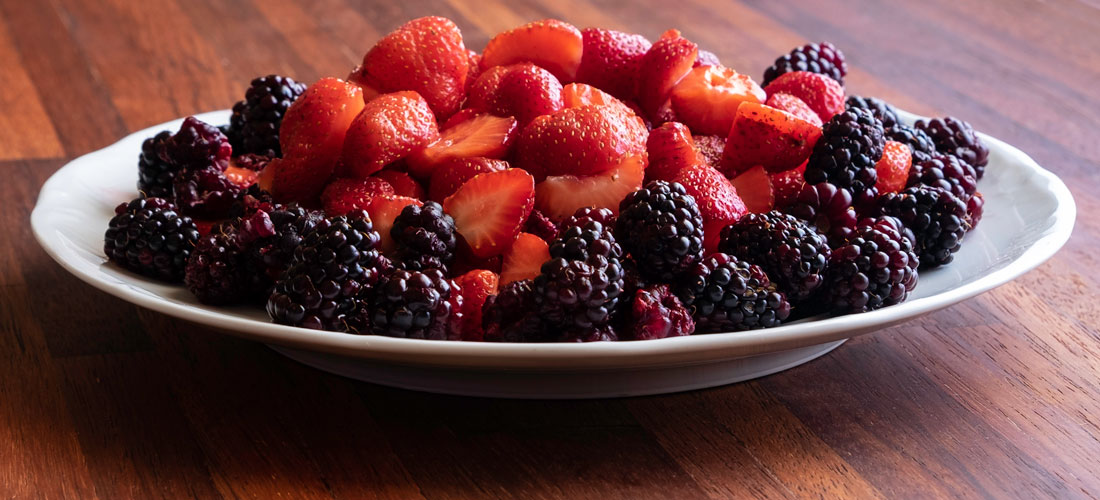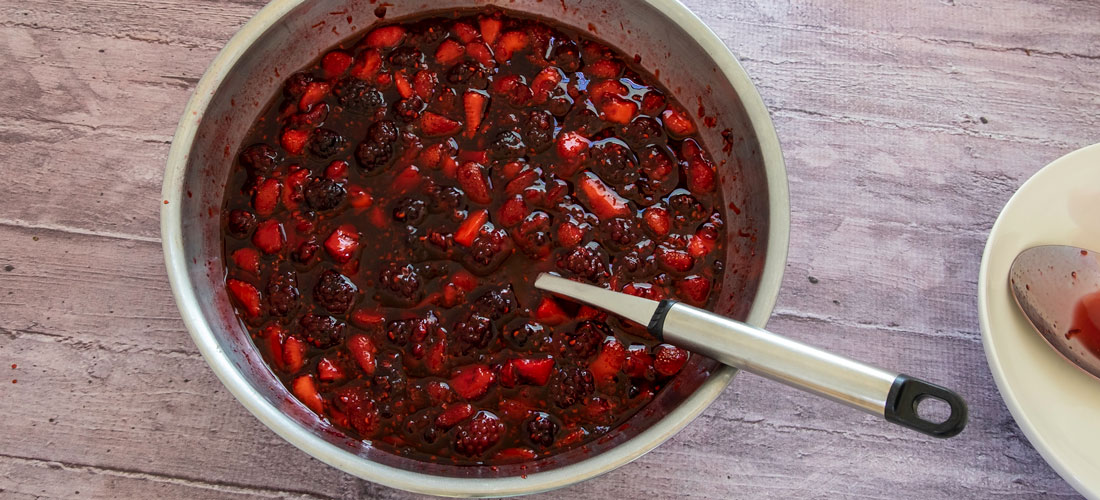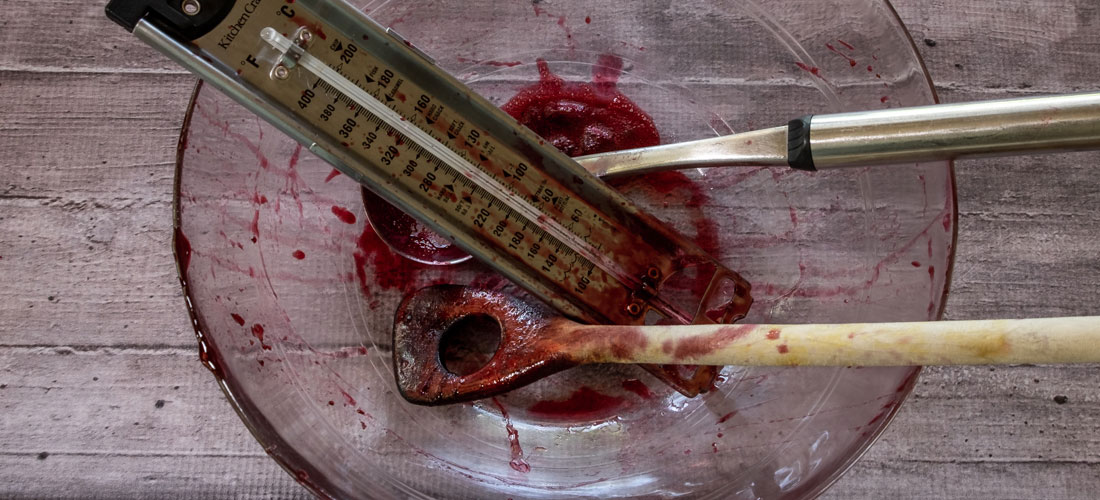Mixed Berry Jam
- Jams, Jellies & Marmalades

This is unquestionably a sensational jam for berry lovers. While home-made strawberry, raspberry or any of the other berries are fabulous, combine them, and a masterpiece is created. It’s red, red, red from the melange of red, crimson, and deep purple of the berries. Its flavour is intense. Sweet, with the right amount of tang and with rich fruity and floral notes. Its perfume is intoxicating. This twostep process of macerating the fruit overnight in sugar, draws out the colour and flavour. Once it’s in the pot, bubbling away, the heady aromas of berries galore, will make your spirit will fly, your heart sing.
A quintessential summer jam, it can be enjoyed on your favourite breakfast bakery item, with scones and cream, used in biscuits and tarts, as a dessert accompaniment or as an indulgent ice-cream topping. Alternatively, it’s a luxurious culinary gift. A different combination of berries and proportions can be used. This is a fabulous starting point for your mixed berry experiment.
- Preparation Time:
- 30 minutes
- Cooking Time:
- 15 minutes
- Quantity:
- 7 x 200ml jars
INGREDIENTS
- 250g
- Strawberries
- 250g
- Silvanberries
- 250g
- Raspberries
- 250g
- Youngberries
- 1
- Lemon rind
- 60 ml
- Lemon juice- strained
- 100 ml
- Water

METHOD
Remove any stems from the berries and gently wash. Remove excess moisture, by gently patting dry or allow to rest on a clean dry tea towel.
Cut any large strawberries in half or quarters depending upon their size. This will speed up the cooking time, while still providing nice fruit chunks in the jam.
Place all the fruit in a large bowl. Gently mix in the rind, lemon juice and sugar until all the ingredients are incorporated. Cover, refrigerate and allow to macerate overnight.
The next day, stir well, and strain the accumulated juices into a preserving pan or large heavy bottomed stainless-steel pot. Put berries aside as these will be put into the jam later.
Add the water and bring the juice to the boil, slowly at first to ensure all the sugar is dissolved. Then boil rapidly until it reaches the setting point at 105 degrees C (220 degrees F ).
Carefully add the berries and bring back to the boil. Continue to boil rapidly until the setting point is reached again. Skim often, with a sharp-edged spoon or ladle, to remove the scum that accumulates around the edge of the pot. Beware of hot spluttering jam-it can easily burn uncovered arms and hands.
Carefully stir occasionally to prevent the fruit from sticking to the bottom of the pot.
-
Remove from the heat, place on a heat resistant surface/board and allow to sit for 5-10 minutes to ensure the fruit is evenly distributed.
Using a wide-necked funnel, ladle into warm sterilised jars, to within 2.5 cm (1 inch) from the top of the jar, being carefully to distribute the fruit evenly between the jars.
-
Cover with sterilised lids or with melted paraffin wax while the jam is still hot. If sealing with wax, once it has set , cover with cellulose or plastic film and secure with a rubber band or string. Alternatively allow jam to cool completely and seal with screw top lid or cellophane paper.
The hot methods of sealing are preferred as there is reduced risk of contamination prior to sealing.
-
Label and store in a cool dark place in the kitchen or pantry.
Allow the jam to mature for at least 2 weeks before eating.
NOTES
- If you don’t have a preserving pan, use large heavy bottom pot, preferably stainless steel. Ensure there is enough space available in the pot for the mixture to double in size while it is rapidly boiling.
- Choose ripened clean berries. Do not use overripe and never use mouldy fruit as this will produce a poor-quality jam.
- Some recipes refer to hulling the strawberries. This is the same as removing the green tip (calyx) and stem.
- Ensure the sugar has completely dissolved before boiling otherwise the sugar may crystallise later in the jar.
- Rapidly boil the jam until it reaches the setting point, stirring occasionally to prevent the jam from sticking on the bottom of the pot. But not too often as this will lower the temperature and delays reaching the setting point.
- Long slow simmering at this point will affect its colour and flavour.
- Berries have a low acid content and require the addition of lemon juice to produce a set. Refer to my post, What Makes Jam, Jelly, Marmalade Set, to understand how preserves set. It also contains a handy Acid and Pectin Chart so you can get even your most creative combinations to set.
- If for some reason, a jam doesn’t set don’t discard it. It can be used as a delicious sauce to accompany cake, dessert or spooned lovingly over ice-cream.
- This jam does not contain a lot of liquid so should set quickly.
- Removing the scum
- Jam, jellies, and marmalades can produce a scum while they are boiling. Impurities from the fruit and sugar will rise to the surface and a fine frothy foam will move towards the edge of the preserving pan. Some fruits will produce more scum that others.
- This is a natural self-clarification process and makes the task of making a high-quality preserve make easier.
- Removing the scum increases the preserve’s clarity. This is very important if it is being submitted for competition. Remove the scum before bottling. Using a stainless-steel spoon, skim the scum from around the edge of the preserving pan. Be careful to remove just the scum and not the jam. This can be done while the jam is boiling and/or once it has been taken off the heat. Do not attempt to remove the scum from the centre of the boiling jam, as there is a high risk the jam with splutter and hot jam burns.
- Some preservers add a small knob on butter (25g per 900g fruit) to the fruit mixture after the sugar has been added. This helps to prevent the formation of scum.
- Using paraffin Wax
- Paraffin wax is available in speciality preserving stores and some rural hardware stores.
- The melted wax must be poured over the preserve while it is hot.
- Break the wax into small pieces and heat in a bowl set over a pan of hot water. Bring to the boil, reduce the heat to maintain a gentle simmer until the wax is just melted
- Do not overheat. If it gets too hot it will shrink away from the sides of the preserving jar as it cools. This will break the seal and allow impurities to access the contents, encouraging mould growth.
- Working quickly pour a thin layer over the hot preserve. Using a small wooden cocktail stick, toothpick, or cake skewer, prick any air bubbles.
- Allow the wax to set. Then pour a second thin layer to make a seal approximately 3mm thick.
- When the wax has set it will become opaque and dip slightly in the middle.
- To use the preserve, break the wax seal and remove.
- Cover the jar with clear film and store in the fridge. Sealing with wax is not a long-term solution. Use within a couple of months
- Variations: The proportion of berries can be changed depending upon availability and according to your taste. A few drops of rosewater can be added to make a fragrant Middle Eastern inspired jam.
 Luscious sweet & tangy red jam
Luscious sweet & tangy red jam
